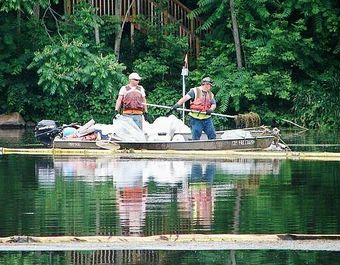 While
cleanup continues three years after the Michigan oil
spill, the U.S. EPA has generally given the
Kalamazoo River a good bill of health. But the
agency is still concerned that 180,000 gallons of
submerged oil, some of which is moving towards a
Superfund site, is a threat to the river and to
people living nearby. Credit: David Hasemyer,
InsideClimate News, in Marshall, Mich., in June 2013
While
cleanup continues three years after the Michigan oil
spill, the U.S. EPA has generally given the
Kalamazoo River a good bill of health. But the
agency is still concerned that 180,000 gallons of
submerged oil, some of which is moving towards a
Superfund site, is a threat to the river and to
people living nearby. Credit: David Hasemyer,
InsideClimate News, in Marshall, Mich., in June 2013
The Kalamazoo River near Marshall, Mich. is a place of serenity these days. It ripples lazily past new parks and boat launches, past red barns and corn fields, past hikers and children in tire swings. Fish do somersaults and land with a splash. Dragonflies dart about like trapeze artists.
The only clues to the environmental disaster that occurred here three years ago are subtle ones. The rainbow sheens of oil that occasionally surface. The collection booms that still stretch across parts of the river. The riverside kiosks stocked with pamphlets titled "What Should I Do If I Come Into Contact With Oil?"
It was near Marshall that an aging oil pipeline burst on July 25, 2010 and spilled more than one million gallons of heavy Canadian crude oil into the Kalamazoo River. It was the largest inland oil pipeline spill in U.S. history, and its effects can still be seen today in the river and in the lives of the people who live near it. The Environmental Protection Agency estimates as much as 180,000 gallons of oil still lie on the river bottom and some of it is moving toward a Superfund site.
"I know what lies beneath," said Deb Miller, who was forced to close her family business because of the spill. "You can clean it up and try to put things back the way they were, but it will never be the same."
Click here to view an audio slide show about the three-year anniversary of the spill by InsideClimate News reporters David Hasemyer and Lisa Song.
The Kalamazoo accident was the first major pipeline spill involving diluted bitumen, or dilbit, the same type of oil that will be carried by the Keystone XL pipeline if the Obama administration approves the project.
Bitumen is a tar-like substance that must be diluted with liquid chemicals before it can flow through pipelines. When the Michigan pipeline split open, the chemicals slowly evaporated and the bitumen began sinking to the river bottom.
The spill turned the river and little Talmadge Creek black with oil. The air was so rank with toxic stink that emergency hotlines were flooded with calls from people sickened by the fumes.
It was a chaotic scene of evacuations, armies of cleanup crews, stunned officials and anxious neighbors. It took the pipeline's owner, Enbridge, Inc., 17 hours to shut it down. The oil flowed past a historic dam near Miller's home and nearly 40 miles downriver.
Today, Line 6B is again pumping Canadian oil to U.S. refineries, while Enbridge builds a new, larger pipeline to replace it. People have moved back into some of the homes that were evacuated, while others have settled into new lives in houses far from the river.
Both the EPA and the Michigan Department of Environmental Quality (MDEQ) give the river a generally clean bill of health. But the EPA's Ralph Dollhopf, who has supervised the cleanup for the last three years, says, "We know we are not going to get all of the oil out."
The EPA has ordered Enbridge to dredge parts of the river and remove as much of the remaining oil as possible. Enbridge says it will comply, although it disputes the EPA's estimates, saying no more than 25,000 gallons of oil remain.
"You can look at the river and say it looks good but there are so many things that fly under the radar—those are the things that we will be monitoring for years," said Michelle DeLong, who is leading the MDEQ's response to the spill.
In the largest study in its history, the MDEQ has collected more than 5,000 soil and groundwater samples to determine if they contain heavy metals, including nickel, beryllium, molybdenum and vanadium, which are toxic at high doses. Heavy metals are found in all types of oil but are most prevalent in bitumen. Some, like arsenic and lead, can damage the nervous system even at relatively low doses.
It will be a year or more before all the samples are analyzed and conclusions can be reached, said Mark Ducharme, senior environmental analyst for MDEQ. Most of the preliminary tests reveal nothing alarming, although a few locations show elevated concentrations of heavy metals and chemicals.
The MDEQ also is considering a proposal by Enbridge and the EPA to tear down the century-old Ceresco Dam, where much of the remaining oil has settled.
The dam once supplied water to a small hydroelectric plant that closed more than 50 years ago. Removing it would return that section of the Kalamazoo to its natural, free-flowing state. It also would reduce the amount of dredging needed, because the oil-soaked sediment would dry when the water level drops and could be scooped up and hauled away.

© InsideClimate News
